Youth Violence: Exploring Multiple Theories
VerifiedAdded on 2023/01/12
|12
|3698
|54
AI Summary
This study aims to critically explore the statement that youth violence cannot be explained by a single theory. It examines various theories, statistics, and factors influencing youth violence. The literature review discusses perceptions of youth violence and crime, statistics on youth violence, and major theories such as rational choice theory, routine activity theory, strain theory, differential association theory, integrated cognitive antisocial potential theory, and gangs theory. The study concludes that youth violence is a complex issue influenced by multiple factors.
Contribute Materials
Your contribution can guide someone’s learning journey. Share your
documents today.
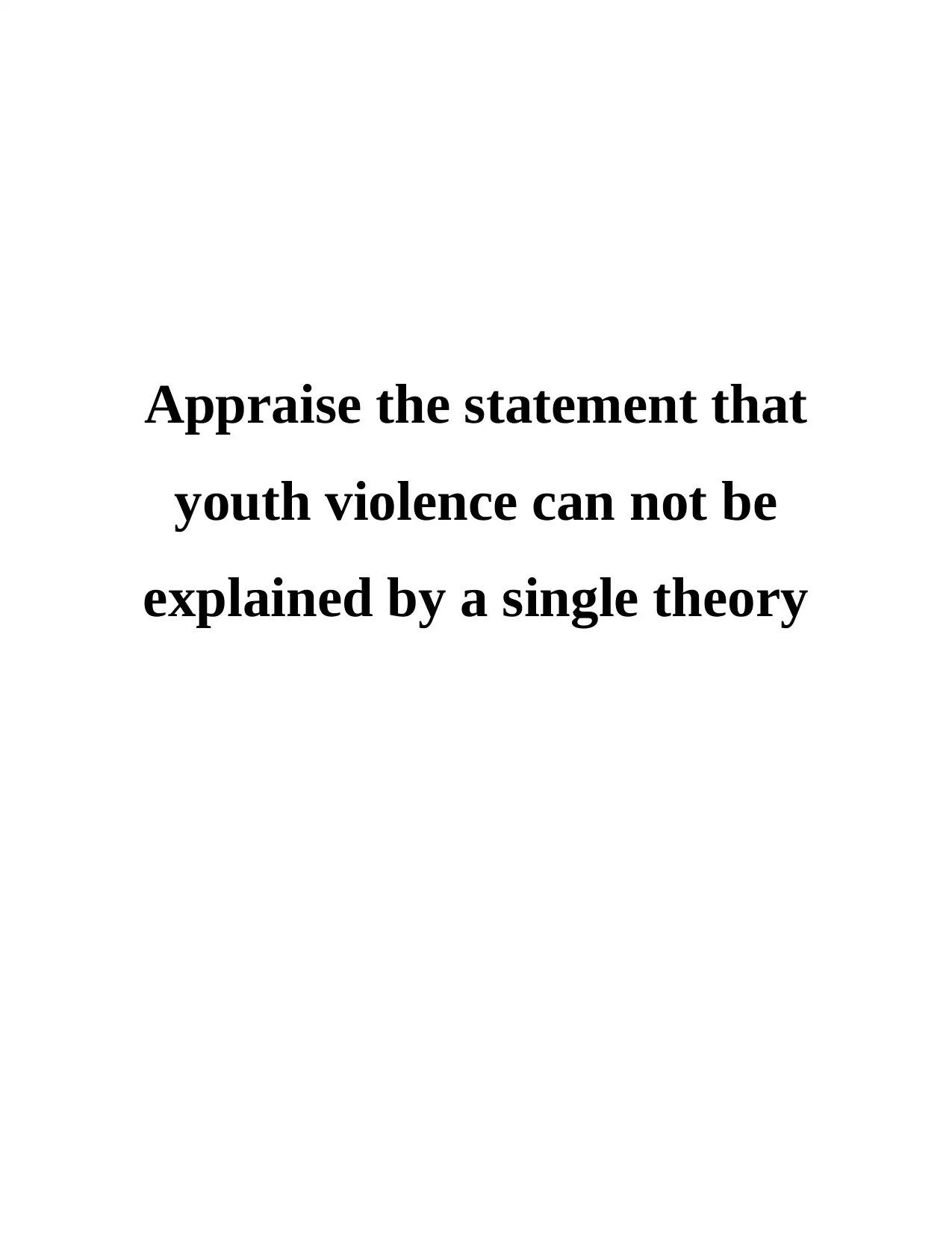
Appraise the statement that
youth violence can not be
explained by a single theory
youth violence can not be
explained by a single theory
Secure Best Marks with AI Grader
Need help grading? Try our AI Grader for instant feedback on your assignments.

TABLE OF CONTENTS
INTRODUCTION...........................................................................................................................1
Background.................................................................................................................................1
Aim and Objectives of the study.................................................................................................1
LITERATURE.................................................................................................................................1
CONCLUSION................................................................................................................................7
REFERENCES................................................................................................................................9
INTRODUCTION...........................................................................................................................1
Background.................................................................................................................................1
Aim and Objectives of the study.................................................................................................1
LITERATURE.................................................................................................................................1
CONCLUSION................................................................................................................................7
REFERENCES................................................................................................................................9
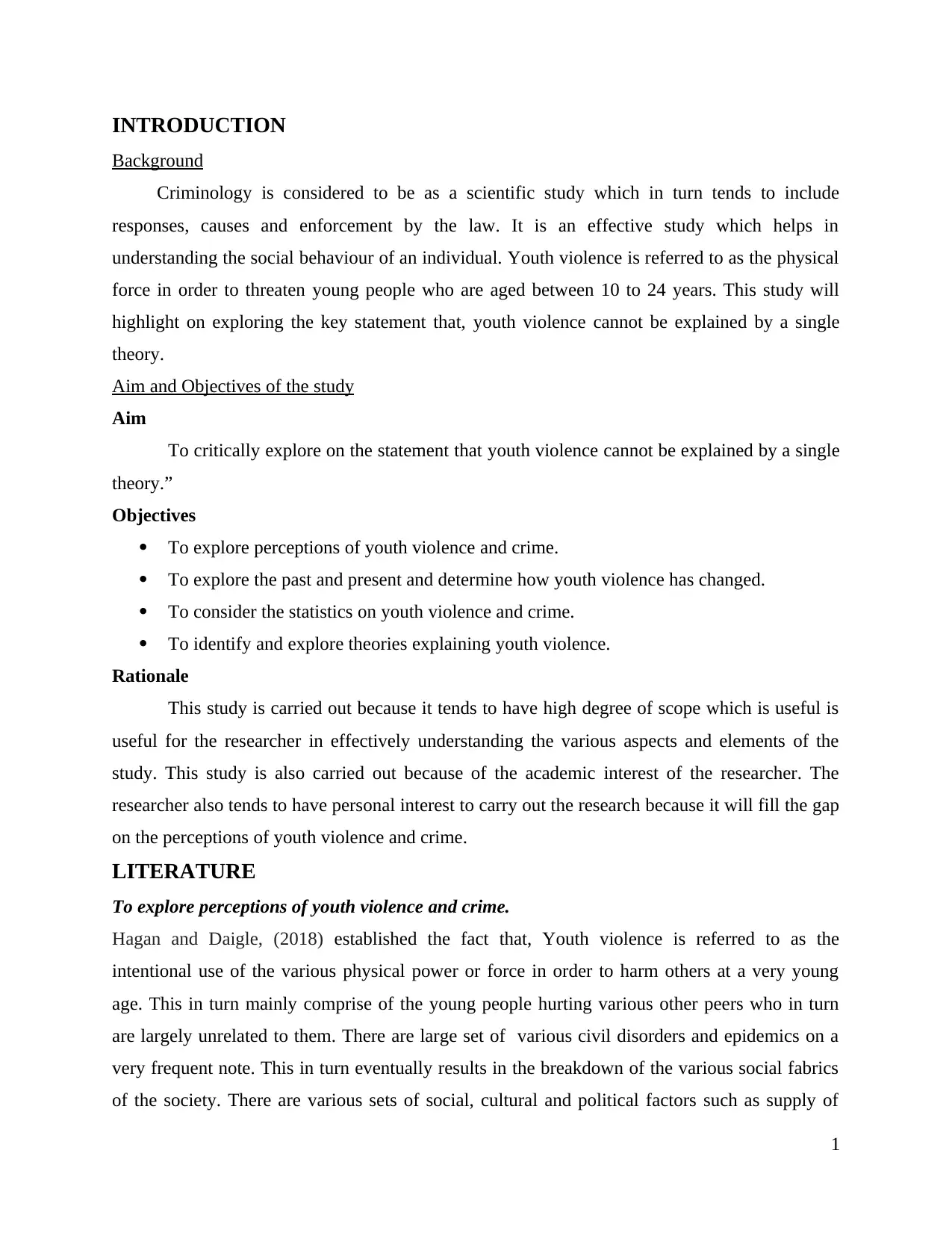
INTRODUCTION
Background
Criminology is considered to be as a scientific study which in turn tends to include
responses, causes and enforcement by the law. It is an effective study which helps in
understanding the social behaviour of an individual. Youth violence is referred to as the physical
force in order to threaten young people who are aged between 10 to 24 years. This study will
highlight on exploring the key statement that, youth violence cannot be explained by a single
theory.
Aim and Objectives of the study
Aim
To critically explore on the statement that youth violence cannot be explained by a single
theory.”
Objectives
To explore perceptions of youth violence and crime.
To explore the past and present and determine how youth violence has changed.
To consider the statistics on youth violence and crime.
To identify and explore theories explaining youth violence.
Rationale
This study is carried out because it tends to have high degree of scope which is useful is
useful for the researcher in effectively understanding the various aspects and elements of the
study. This study is also carried out because of the academic interest of the researcher. The
researcher also tends to have personal interest to carry out the research because it will fill the gap
on the perceptions of youth violence and crime.
LITERATURE
To explore perceptions of youth violence and crime.
Hagan and Daigle, (2018) established the fact that, Youth violence is referred to as the
intentional use of the various physical power or force in order to harm others at a very young
age. This in turn mainly comprise of the young people hurting various other peers who in turn
are largely unrelated to them. There are large set of various civil disorders and epidemics on a
very frequent note. This in turn eventually results in the breakdown of the various social fabrics
of the society. There are various sets of social, cultural and political factors such as supply of
1
Background
Criminology is considered to be as a scientific study which in turn tends to include
responses, causes and enforcement by the law. It is an effective study which helps in
understanding the social behaviour of an individual. Youth violence is referred to as the physical
force in order to threaten young people who are aged between 10 to 24 years. This study will
highlight on exploring the key statement that, youth violence cannot be explained by a single
theory.
Aim and Objectives of the study
Aim
To critically explore on the statement that youth violence cannot be explained by a single
theory.”
Objectives
To explore perceptions of youth violence and crime.
To explore the past and present and determine how youth violence has changed.
To consider the statistics on youth violence and crime.
To identify and explore theories explaining youth violence.
Rationale
This study is carried out because it tends to have high degree of scope which is useful is
useful for the researcher in effectively understanding the various aspects and elements of the
study. This study is also carried out because of the academic interest of the researcher. The
researcher also tends to have personal interest to carry out the research because it will fill the gap
on the perceptions of youth violence and crime.
LITERATURE
To explore perceptions of youth violence and crime.
Hagan and Daigle, (2018) established the fact that, Youth violence is referred to as the
intentional use of the various physical power or force in order to harm others at a very young
age. This in turn mainly comprise of the young people hurting various other peers who in turn
are largely unrelated to them. There are large set of various civil disorders and epidemics on a
very frequent note. This in turn eventually results in the breakdown of the various social fabrics
of the society. There are various sets of social, cultural and political factors such as supply of
1
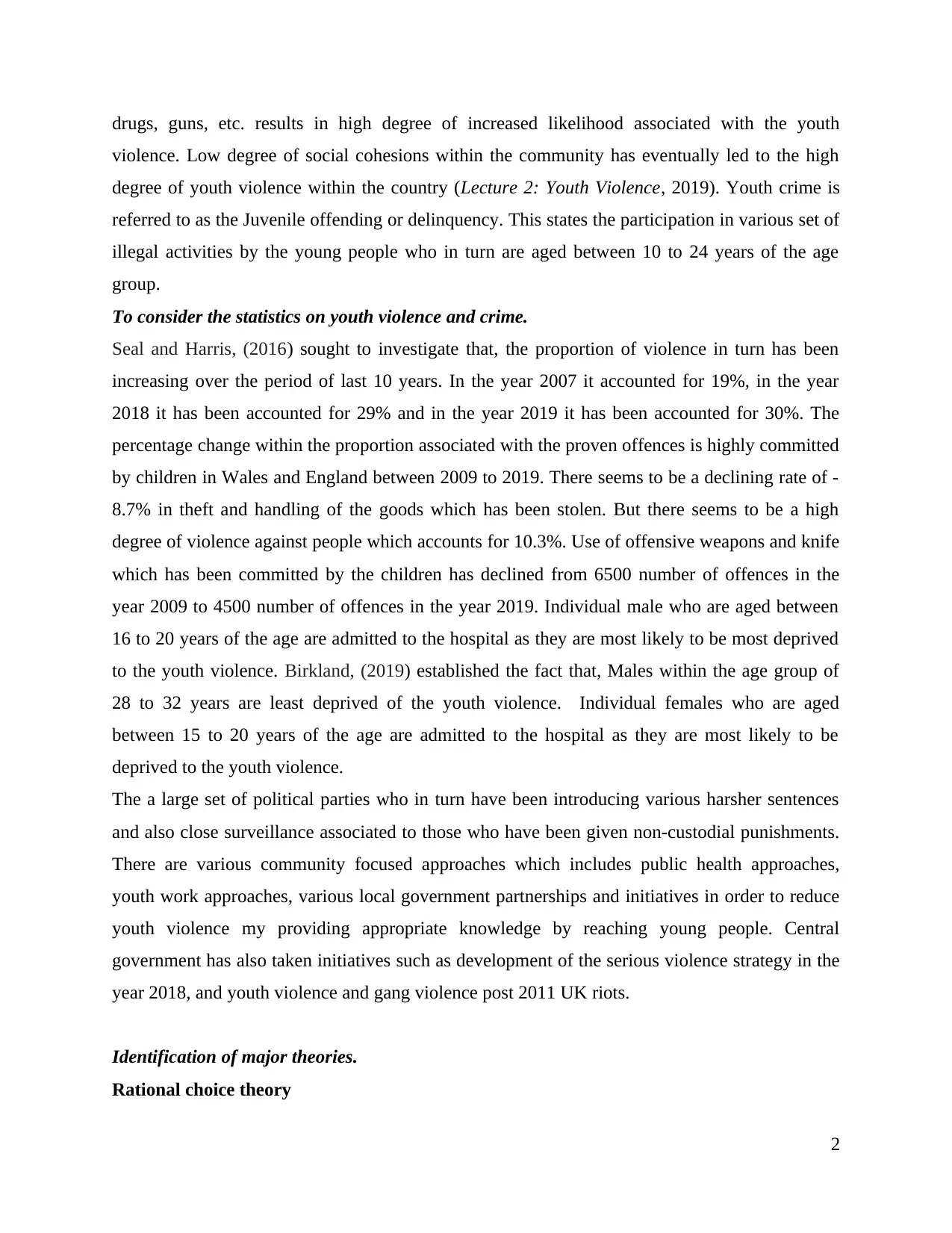
drugs, guns, etc. results in high degree of increased likelihood associated with the youth
violence. Low degree of social cohesions within the community has eventually led to the high
degree of youth violence within the country (Lecture 2: Youth Violence, 2019). Youth crime is
referred to as the Juvenile offending or delinquency. This states the participation in various set of
illegal activities by the young people who in turn are aged between 10 to 24 years of the age
group.
To consider the statistics on youth violence and crime.
Seal and Harris, (2016) sought to investigate that, the proportion of violence in turn has been
increasing over the period of last 10 years. In the year 2007 it accounted for 19%, in the year
2018 it has been accounted for 29% and in the year 2019 it has been accounted for 30%. The
percentage change within the proportion associated with the proven offences is highly committed
by children in Wales and England between 2009 to 2019. There seems to be a declining rate of -
8.7% in theft and handling of the goods which has been stolen. But there seems to be a high
degree of violence against people which accounts for 10.3%. Use of offensive weapons and knife
which has been committed by the children has declined from 6500 number of offences in the
year 2009 to 4500 number of offences in the year 2019. Individual male who are aged between
16 to 20 years of the age are admitted to the hospital as they are most likely to be most deprived
to the youth violence. Birkland, (2019) established the fact that, Males within the age group of
28 to 32 years are least deprived of the youth violence. Individual females who are aged
between 15 to 20 years of the age are admitted to the hospital as they are most likely to be
deprived to the youth violence.
The a large set of political parties who in turn have been introducing various harsher sentences
and also close surveillance associated to those who have been given non-custodial punishments.
There are various community focused approaches which includes public health approaches,
youth work approaches, various local government partnerships and initiatives in order to reduce
youth violence my providing appropriate knowledge by reaching young people. Central
government has also taken initiatives such as development of the serious violence strategy in the
year 2018, and youth violence and gang violence post 2011 UK riots.
Identification of major theories.
Rational choice theory
2
violence. Low degree of social cohesions within the community has eventually led to the high
degree of youth violence within the country (Lecture 2: Youth Violence, 2019). Youth crime is
referred to as the Juvenile offending or delinquency. This states the participation in various set of
illegal activities by the young people who in turn are aged between 10 to 24 years of the age
group.
To consider the statistics on youth violence and crime.
Seal and Harris, (2016) sought to investigate that, the proportion of violence in turn has been
increasing over the period of last 10 years. In the year 2007 it accounted for 19%, in the year
2018 it has been accounted for 29% and in the year 2019 it has been accounted for 30%. The
percentage change within the proportion associated with the proven offences is highly committed
by children in Wales and England between 2009 to 2019. There seems to be a declining rate of -
8.7% in theft and handling of the goods which has been stolen. But there seems to be a high
degree of violence against people which accounts for 10.3%. Use of offensive weapons and knife
which has been committed by the children has declined from 6500 number of offences in the
year 2009 to 4500 number of offences in the year 2019. Individual male who are aged between
16 to 20 years of the age are admitted to the hospital as they are most likely to be most deprived
to the youth violence. Birkland, (2019) established the fact that, Males within the age group of
28 to 32 years are least deprived of the youth violence. Individual females who are aged
between 15 to 20 years of the age are admitted to the hospital as they are most likely to be
deprived to the youth violence.
The a large set of political parties who in turn have been introducing various harsher sentences
and also close surveillance associated to those who have been given non-custodial punishments.
There are various community focused approaches which includes public health approaches,
youth work approaches, various local government partnerships and initiatives in order to reduce
youth violence my providing appropriate knowledge by reaching young people. Central
government has also taken initiatives such as development of the serious violence strategy in the
year 2018, and youth violence and gang violence post 2011 UK riots.
Identification of major theories.
Rational choice theory
2
Secure Best Marks with AI Grader
Need help grading? Try our AI Grader for instant feedback on your assignments.

Capuzzi and Stauffer, (2016) sought to investigate that, Rational choice theory has its origins to
older experimental findings and hypothesizes from scientific researches of human behavior. It
helps to understand why people might find violent and generally unacceptable acts to be rational
and the reasons supporting such circumstances to account for youth violence.
Harmonic changes during youth make them socially very vulnerable to the feeling of loneliness
and makes them avoid stress and pain by both internal and external factors. This mentality often
reinforces delinquent behavior that supports antisocial activity.
Social models also demonstrate common characteristics of crimes committed by young people.
Most crimes gave the offender some sort of reward or was emotionally satisfying and fun for the
person. This gives us a perspective into the minds of youth who would find violence amusing.
Bushman and et.al., (2016) sought to investigate that, The theory is based on the premise that
people are inherently rational and the acts can be contained by some form of punishment and
behavior can be modified by the fear of it. This tells us that constitutional punishments are
helpful in reducing crimes as choice of violence seems less rewarding and fear interrupts in the
feeling of satisfaction.
The feeling of powerlessness has the potential to induce violence. People who feel they are weak
use violence as a self-defense mechanism to reduce their risks. Also, violence offenders mostly
victimize defenseless victims and avoid powerful and armed victims.
Routine activity theory
Barlow, (2015) sought to investigate that, Routine activity theory was given by Lawrence Cohen
and Marcus Felson in 1979 to understand relation between crime rates and social factors. It
studies different scenarios in which a person is more likely to commit a crime. It has been
applied to many robberies, murders and other violent crimes.
It states that crime occurs with a motivated offender, vulnerable target and lack of guardianship.
This is especially true for youth violence as willingness to commit a crime is high among youth
as they do not consider the after effects.
Guardianship helps to guide youth to deter from violent behavior. When a motivated individual
finds someone who is vulnerable and weak only proper guidance can avert crimes. It also tells
about the effect of daily routine activities on the type of violence one is likely to commit
(Lecture 2: Youth Violence, 2019).
3
older experimental findings and hypothesizes from scientific researches of human behavior. It
helps to understand why people might find violent and generally unacceptable acts to be rational
and the reasons supporting such circumstances to account for youth violence.
Harmonic changes during youth make them socially very vulnerable to the feeling of loneliness
and makes them avoid stress and pain by both internal and external factors. This mentality often
reinforces delinquent behavior that supports antisocial activity.
Social models also demonstrate common characteristics of crimes committed by young people.
Most crimes gave the offender some sort of reward or was emotionally satisfying and fun for the
person. This gives us a perspective into the minds of youth who would find violence amusing.
Bushman and et.al., (2016) sought to investigate that, The theory is based on the premise that
people are inherently rational and the acts can be contained by some form of punishment and
behavior can be modified by the fear of it. This tells us that constitutional punishments are
helpful in reducing crimes as choice of violence seems less rewarding and fear interrupts in the
feeling of satisfaction.
The feeling of powerlessness has the potential to induce violence. People who feel they are weak
use violence as a self-defense mechanism to reduce their risks. Also, violence offenders mostly
victimize defenseless victims and avoid powerful and armed victims.
Routine activity theory
Barlow, (2015) sought to investigate that, Routine activity theory was given by Lawrence Cohen
and Marcus Felson in 1979 to understand relation between crime rates and social factors. It
studies different scenarios in which a person is more likely to commit a crime. It has been
applied to many robberies, murders and other violent crimes.
It states that crime occurs with a motivated offender, vulnerable target and lack of guardianship.
This is especially true for youth violence as willingness to commit a crime is high among youth
as they do not consider the after effects.
Guardianship helps to guide youth to deter from violent behavior. When a motivated individual
finds someone who is vulnerable and weak only proper guidance can avert crimes. It also tells
about the effect of daily routine activities on the type of violence one is likely to commit
(Lecture 2: Youth Violence, 2019).
3
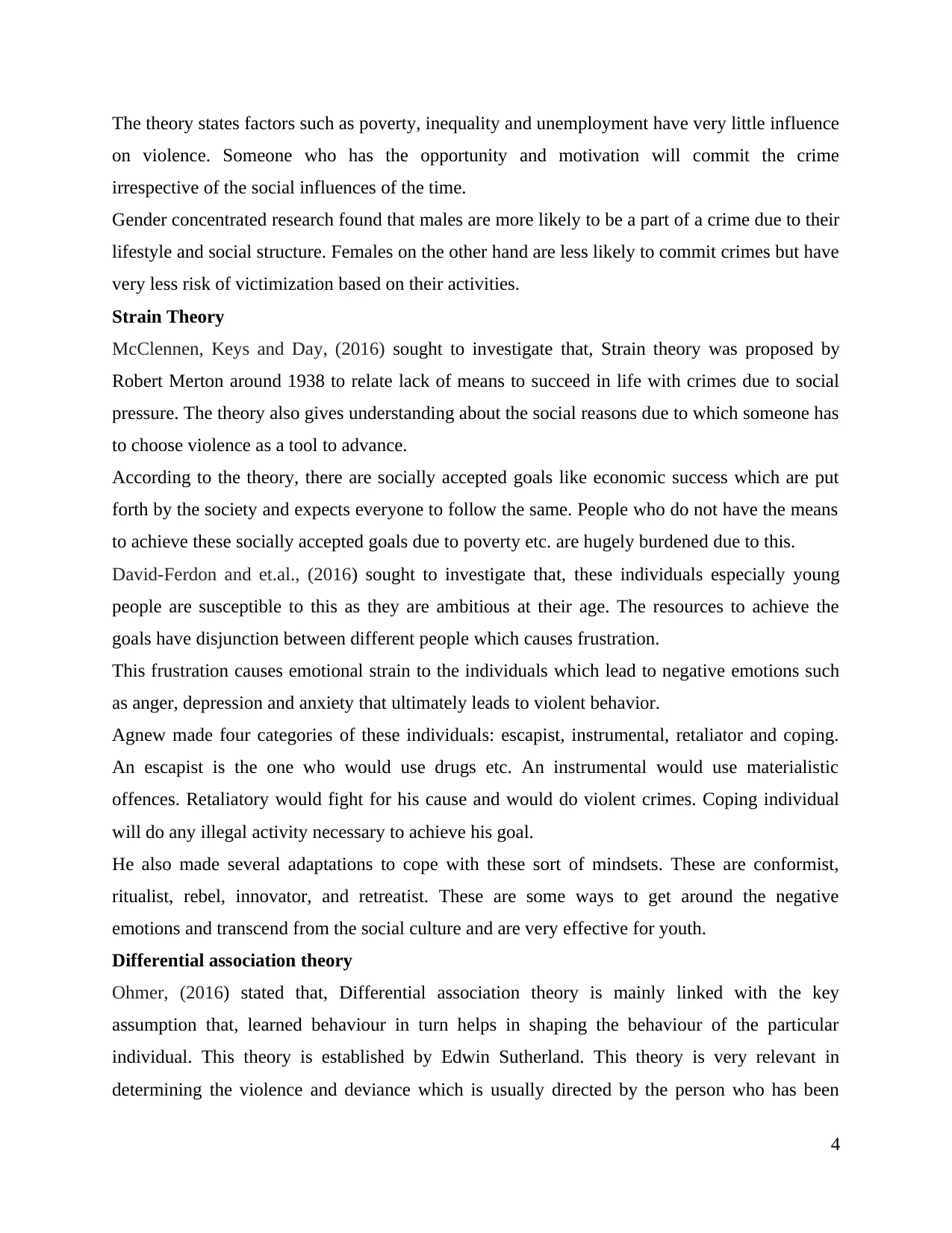
The theory states factors such as poverty, inequality and unemployment have very little influence
on violence. Someone who has the opportunity and motivation will commit the crime
irrespective of the social influences of the time.
Gender concentrated research found that males are more likely to be a part of a crime due to their
lifestyle and social structure. Females on the other hand are less likely to commit crimes but have
very less risk of victimization based on their activities.
Strain Theory
McClennen, Keys and Day, (2016) sought to investigate that, Strain theory was proposed by
Robert Merton around 1938 to relate lack of means to succeed in life with crimes due to social
pressure. The theory also gives understanding about the social reasons due to which someone has
to choose violence as a tool to advance.
According to the theory, there are socially accepted goals like economic success which are put
forth by the society and expects everyone to follow the same. People who do not have the means
to achieve these socially accepted goals due to poverty etc. are hugely burdened due to this.
David-Ferdon and et.al., (2016) sought to investigate that, these individuals especially young
people are susceptible to this as they are ambitious at their age. The resources to achieve the
goals have disjunction between different people which causes frustration.
This frustration causes emotional strain to the individuals which lead to negative emotions such
as anger, depression and anxiety that ultimately leads to violent behavior.
Agnew made four categories of these individuals: escapist, instrumental, retaliator and coping.
An escapist is the one who would use drugs etc. An instrumental would use materialistic
offences. Retaliatory would fight for his cause and would do violent crimes. Coping individual
will do any illegal activity necessary to achieve his goal.
He also made several adaptations to cope with these sort of mindsets. These are conformist,
ritualist, rebel, innovator, and retreatist. These are some ways to get around the negative
emotions and transcend from the social culture and are very effective for youth.
Differential association theory
Ohmer, (2016) stated that, Differential association theory is mainly linked with the key
assumption that, learned behaviour in turn helps in shaping the behaviour of the particular
individual. This theory is established by Edwin Sutherland. This theory is very relevant in
determining the violence and deviance which is usually directed by the person who has been
4
on violence. Someone who has the opportunity and motivation will commit the crime
irrespective of the social influences of the time.
Gender concentrated research found that males are more likely to be a part of a crime due to their
lifestyle and social structure. Females on the other hand are less likely to commit crimes but have
very less risk of victimization based on their activities.
Strain Theory
McClennen, Keys and Day, (2016) sought to investigate that, Strain theory was proposed by
Robert Merton around 1938 to relate lack of means to succeed in life with crimes due to social
pressure. The theory also gives understanding about the social reasons due to which someone has
to choose violence as a tool to advance.
According to the theory, there are socially accepted goals like economic success which are put
forth by the society and expects everyone to follow the same. People who do not have the means
to achieve these socially accepted goals due to poverty etc. are hugely burdened due to this.
David-Ferdon and et.al., (2016) sought to investigate that, these individuals especially young
people are susceptible to this as they are ambitious at their age. The resources to achieve the
goals have disjunction between different people which causes frustration.
This frustration causes emotional strain to the individuals which lead to negative emotions such
as anger, depression and anxiety that ultimately leads to violent behavior.
Agnew made four categories of these individuals: escapist, instrumental, retaliator and coping.
An escapist is the one who would use drugs etc. An instrumental would use materialistic
offences. Retaliatory would fight for his cause and would do violent crimes. Coping individual
will do any illegal activity necessary to achieve his goal.
He also made several adaptations to cope with these sort of mindsets. These are conformist,
ritualist, rebel, innovator, and retreatist. These are some ways to get around the negative
emotions and transcend from the social culture and are very effective for youth.
Differential association theory
Ohmer, (2016) stated that, Differential association theory is mainly linked with the key
assumption that, learned behaviour in turn helps in shaping the behaviour of the particular
individual. This theory is established by Edwin Sutherland. This theory is very relevant in
determining the violence and deviance which is usually directed by the person who has been
4
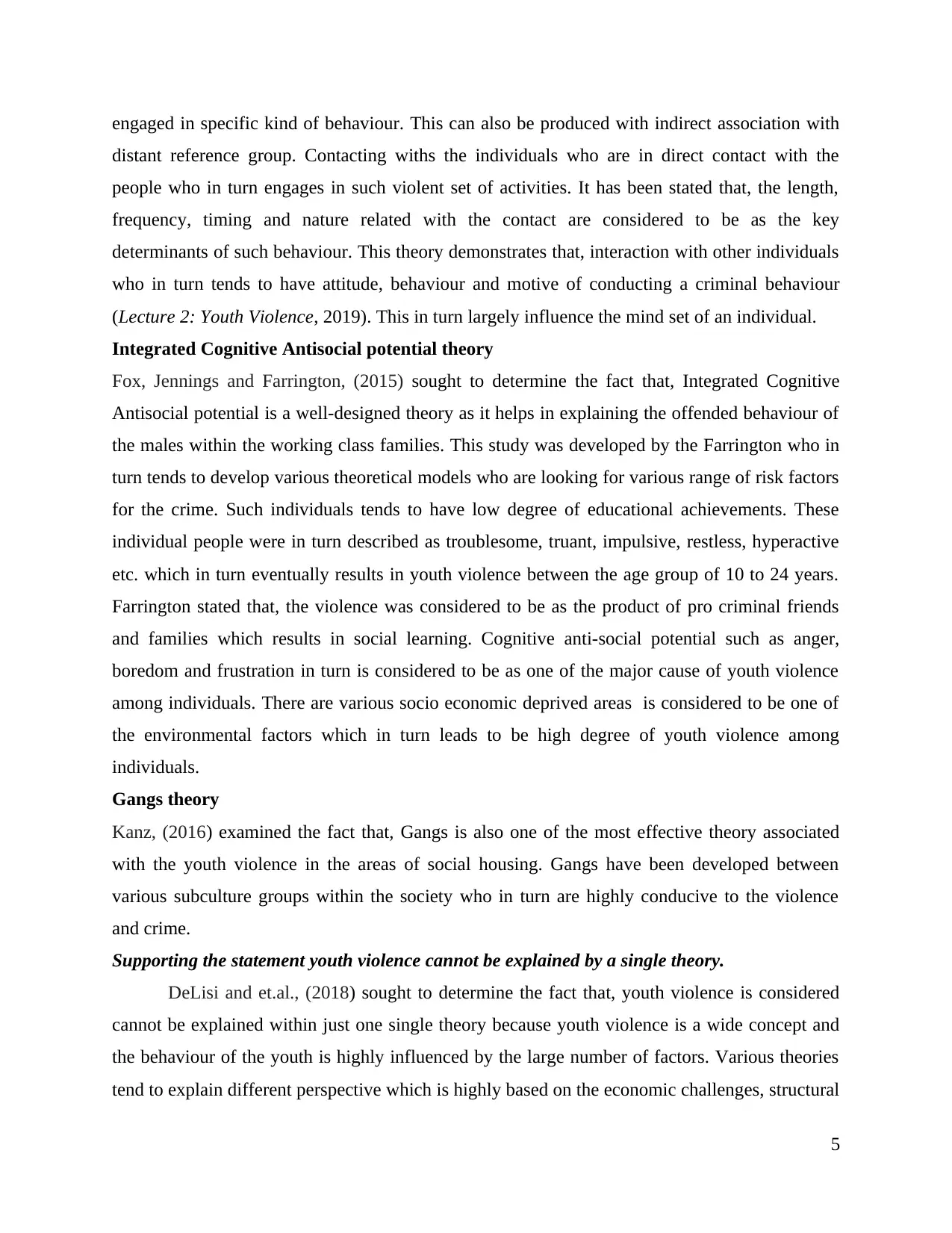
engaged in specific kind of behaviour. This can also be produced with indirect association with
distant reference group. Contacting withs the individuals who are in direct contact with the
people who in turn engages in such violent set of activities. It has been stated that, the length,
frequency, timing and nature related with the contact are considered to be as the key
determinants of such behaviour. This theory demonstrates that, interaction with other individuals
who in turn tends to have attitude, behaviour and motive of conducting a criminal behaviour
(Lecture 2: Youth Violence, 2019). This in turn largely influence the mind set of an individual.
Integrated Cognitive Antisocial potential theory
Fox, Jennings and Farrington, (2015) sought to determine the fact that, Integrated Cognitive
Antisocial potential is a well-designed theory as it helps in explaining the offended behaviour of
the males within the working class families. This study was developed by the Farrington who in
turn tends to develop various theoretical models who are looking for various range of risk factors
for the crime. Such individuals tends to have low degree of educational achievements. These
individual people were in turn described as troublesome, truant, impulsive, restless, hyperactive
etc. which in turn eventually results in youth violence between the age group of 10 to 24 years.
Farrington stated that, the violence was considered to be as the product of pro criminal friends
and families which results in social learning. Cognitive anti-social potential such as anger,
boredom and frustration in turn is considered to be as one of the major cause of youth violence
among individuals. There are various socio economic deprived areas is considered to be one of
the environmental factors which in turn leads to be high degree of youth violence among
individuals.
Gangs theory
Kanz, (2016) examined the fact that, Gangs is also one of the most effective theory associated
with the youth violence in the areas of social housing. Gangs have been developed between
various subculture groups within the society who in turn are highly conducive to the violence
and crime.
Supporting the statement youth violence cannot be explained by a single theory.
DeLisi and et.al., (2018) sought to determine the fact that, youth violence is considered
cannot be explained within just one single theory because youth violence is a wide concept and
the behaviour of the youth is highly influenced by the large number of factors. Various theories
tend to explain different perspective which is highly based on the economic challenges, structural
5
distant reference group. Contacting withs the individuals who are in direct contact with the
people who in turn engages in such violent set of activities. It has been stated that, the length,
frequency, timing and nature related with the contact are considered to be as the key
determinants of such behaviour. This theory demonstrates that, interaction with other individuals
who in turn tends to have attitude, behaviour and motive of conducting a criminal behaviour
(Lecture 2: Youth Violence, 2019). This in turn largely influence the mind set of an individual.
Integrated Cognitive Antisocial potential theory
Fox, Jennings and Farrington, (2015) sought to determine the fact that, Integrated Cognitive
Antisocial potential is a well-designed theory as it helps in explaining the offended behaviour of
the males within the working class families. This study was developed by the Farrington who in
turn tends to develop various theoretical models who are looking for various range of risk factors
for the crime. Such individuals tends to have low degree of educational achievements. These
individual people were in turn described as troublesome, truant, impulsive, restless, hyperactive
etc. which in turn eventually results in youth violence between the age group of 10 to 24 years.
Farrington stated that, the violence was considered to be as the product of pro criminal friends
and families which results in social learning. Cognitive anti-social potential such as anger,
boredom and frustration in turn is considered to be as one of the major cause of youth violence
among individuals. There are various socio economic deprived areas is considered to be one of
the environmental factors which in turn leads to be high degree of youth violence among
individuals.
Gangs theory
Kanz, (2016) examined the fact that, Gangs is also one of the most effective theory associated
with the youth violence in the areas of social housing. Gangs have been developed between
various subculture groups within the society who in turn are highly conducive to the violence
and crime.
Supporting the statement youth violence cannot be explained by a single theory.
DeLisi and et.al., (2018) sought to determine the fact that, youth violence is considered
cannot be explained within just one single theory because youth violence is a wide concept and
the behaviour of the youth is highly influenced by the large number of factors. Various theories
tend to explain different perspective which is highly based on the economic challenges, structural
5
Paraphrase This Document
Need a fresh take? Get an instant paraphrase of this document with our AI Paraphraser
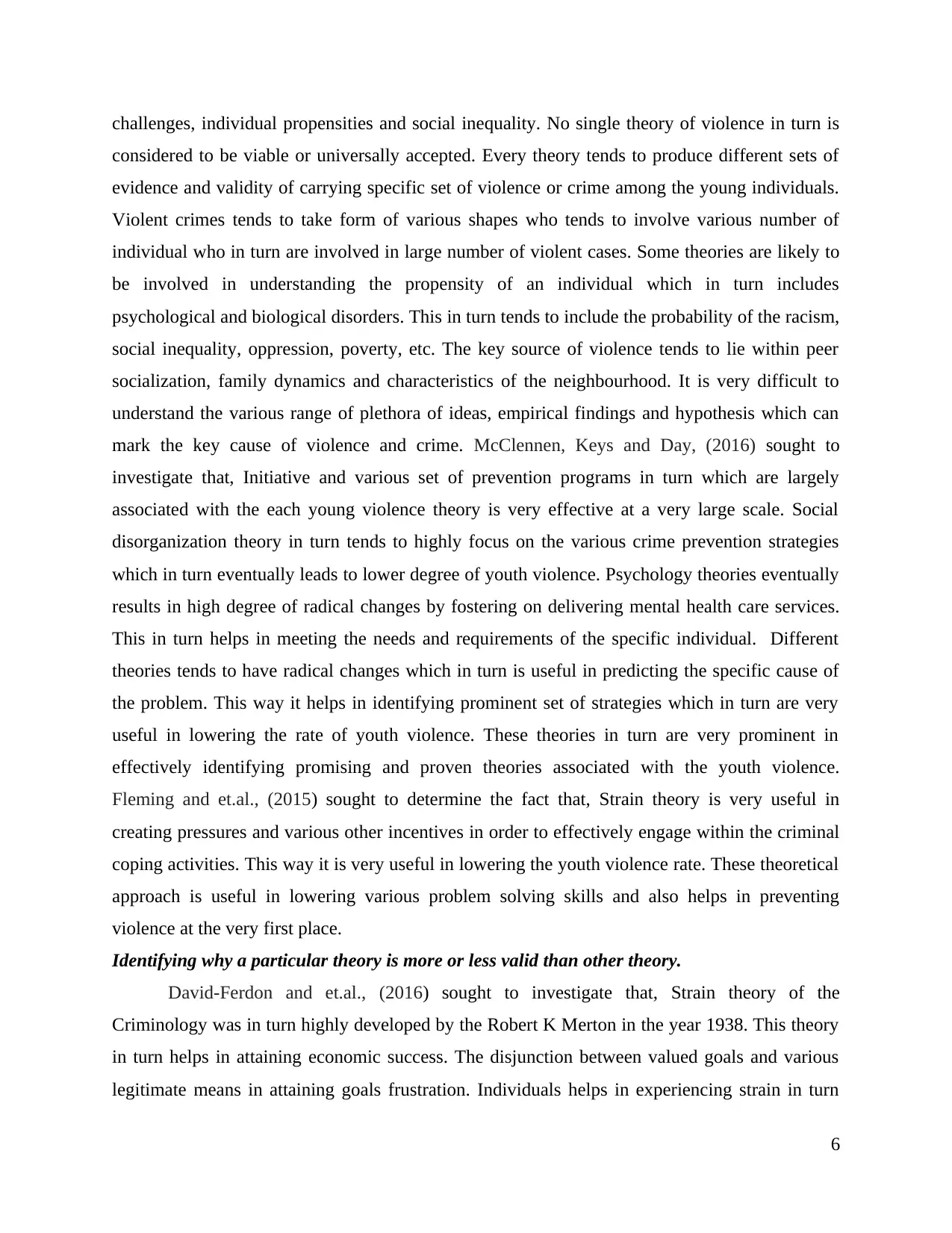
challenges, individual propensities and social inequality. No single theory of violence in turn is
considered to be viable or universally accepted. Every theory tends to produce different sets of
evidence and validity of carrying specific set of violence or crime among the young individuals.
Violent crimes tends to take form of various shapes who tends to involve various number of
individual who in turn are involved in large number of violent cases. Some theories are likely to
be involved in understanding the propensity of an individual which in turn includes
psychological and biological disorders. This in turn tends to include the probability of the racism,
social inequality, oppression, poverty, etc. The key source of violence tends to lie within peer
socialization, family dynamics and characteristics of the neighbourhood. It is very difficult to
understand the various range of plethora of ideas, empirical findings and hypothesis which can
mark the key cause of violence and crime. McClennen, Keys and Day, (2016) sought to
investigate that, Initiative and various set of prevention programs in turn which are largely
associated with the each young violence theory is very effective at a very large scale. Social
disorganization theory in turn tends to highly focus on the various crime prevention strategies
which in turn eventually leads to lower degree of youth violence. Psychology theories eventually
results in high degree of radical changes by fostering on delivering mental health care services.
This in turn helps in meeting the needs and requirements of the specific individual. Different
theories tends to have radical changes which in turn is useful in predicting the specific cause of
the problem. This way it helps in identifying prominent set of strategies which in turn are very
useful in lowering the rate of youth violence. These theories in turn are very prominent in
effectively identifying promising and proven theories associated with the youth violence.
Fleming and et.al., (2015) sought to determine the fact that, Strain theory is very useful in
creating pressures and various other incentives in order to effectively engage within the criminal
coping activities. This way it is very useful in lowering the youth violence rate. These theoretical
approach is useful in lowering various problem solving skills and also helps in preventing
violence at the very first place.
Identifying why a particular theory is more or less valid than other theory.
David-Ferdon and et.al., (2016) sought to investigate that, Strain theory of the
Criminology was in turn highly developed by the Robert K Merton in the year 1938. This theory
in turn helps in attaining economic success. The disjunction between valued goals and various
legitimate means in attaining goals frustration. Individuals helps in experiencing strain in turn
6
considered to be viable or universally accepted. Every theory tends to produce different sets of
evidence and validity of carrying specific set of violence or crime among the young individuals.
Violent crimes tends to take form of various shapes who tends to involve various number of
individual who in turn are involved in large number of violent cases. Some theories are likely to
be involved in understanding the propensity of an individual which in turn includes
psychological and biological disorders. This in turn tends to include the probability of the racism,
social inequality, oppression, poverty, etc. The key source of violence tends to lie within peer
socialization, family dynamics and characteristics of the neighbourhood. It is very difficult to
understand the various range of plethora of ideas, empirical findings and hypothesis which can
mark the key cause of violence and crime. McClennen, Keys and Day, (2016) sought to
investigate that, Initiative and various set of prevention programs in turn which are largely
associated with the each young violence theory is very effective at a very large scale. Social
disorganization theory in turn tends to highly focus on the various crime prevention strategies
which in turn eventually leads to lower degree of youth violence. Psychology theories eventually
results in high degree of radical changes by fostering on delivering mental health care services.
This in turn helps in meeting the needs and requirements of the specific individual. Different
theories tends to have radical changes which in turn is useful in predicting the specific cause of
the problem. This way it helps in identifying prominent set of strategies which in turn are very
useful in lowering the rate of youth violence. These theories in turn are very prominent in
effectively identifying promising and proven theories associated with the youth violence.
Fleming and et.al., (2015) sought to determine the fact that, Strain theory is very useful in
creating pressures and various other incentives in order to effectively engage within the criminal
coping activities. This way it is very useful in lowering the youth violence rate. These theoretical
approach is useful in lowering various problem solving skills and also helps in preventing
violence at the very first place.
Identifying why a particular theory is more or less valid than other theory.
David-Ferdon and et.al., (2016) sought to investigate that, Strain theory of the
Criminology was in turn highly developed by the Robert K Merton in the year 1938. This theory
in turn helps in attaining economic success. The disjunction between valued goals and various
legitimate means in attaining goals frustration. Individuals helps in experiencing strain in turn
6
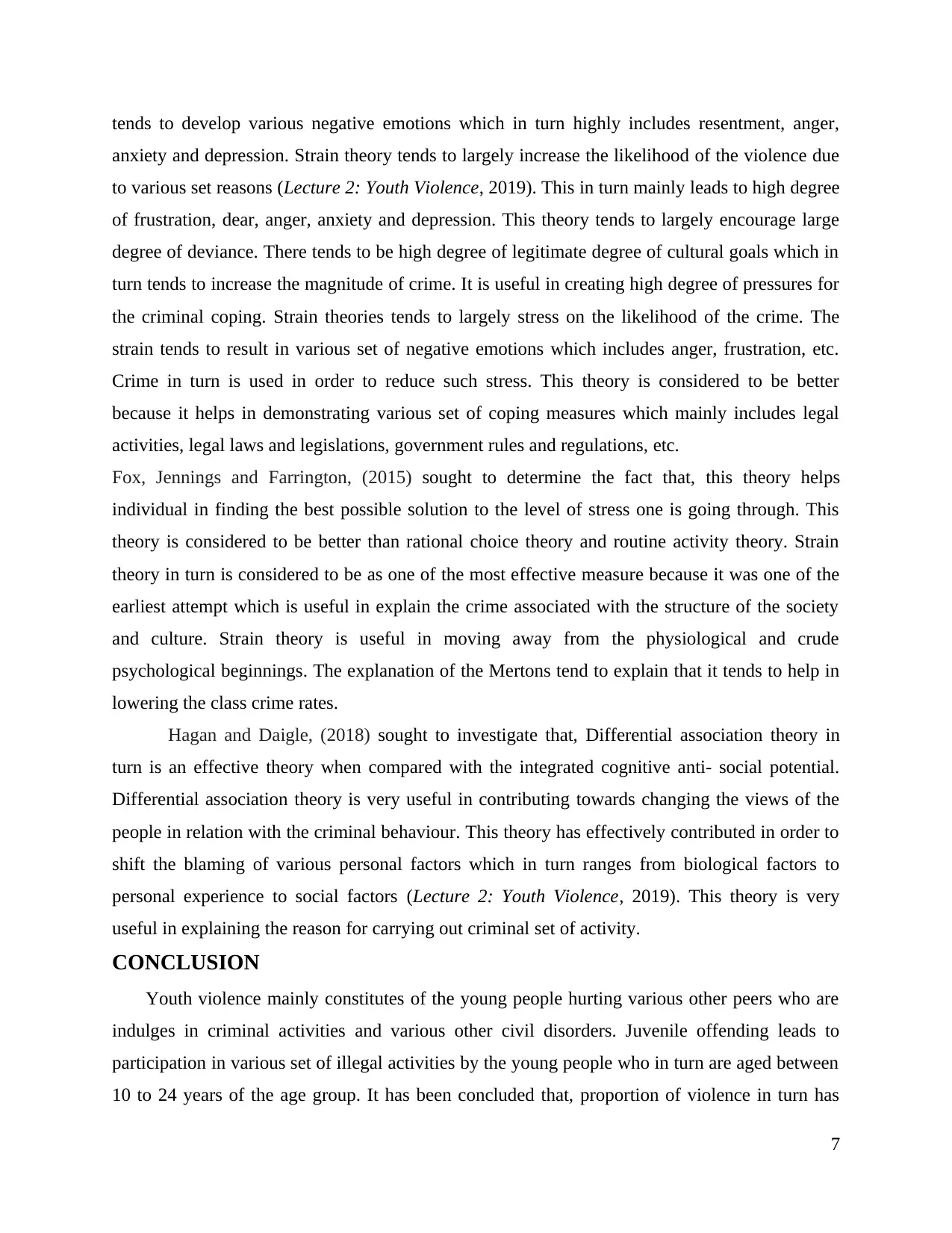
tends to develop various negative emotions which in turn highly includes resentment, anger,
anxiety and depression. Strain theory tends to largely increase the likelihood of the violence due
to various set reasons (Lecture 2: Youth Violence, 2019). This in turn mainly leads to high degree
of frustration, dear, anger, anxiety and depression. This theory tends to largely encourage large
degree of deviance. There tends to be high degree of legitimate degree of cultural goals which in
turn tends to increase the magnitude of crime. It is useful in creating high degree of pressures for
the criminal coping. Strain theories tends to largely stress on the likelihood of the crime. The
strain tends to result in various set of negative emotions which includes anger, frustration, etc.
Crime in turn is used in order to reduce such stress. This theory is considered to be better
because it helps in demonstrating various set of coping measures which mainly includes legal
activities, legal laws and legislations, government rules and regulations, etc.
Fox, Jennings and Farrington, (2015) sought to determine the fact that, this theory helps
individual in finding the best possible solution to the level of stress one is going through. This
theory is considered to be better than rational choice theory and routine activity theory. Strain
theory in turn is considered to be as one of the most effective measure because it was one of the
earliest attempt which is useful in explain the crime associated with the structure of the society
and culture. Strain theory is useful in moving away from the physiological and crude
psychological beginnings. The explanation of the Mertons tend to explain that it tends to help in
lowering the class crime rates.
Hagan and Daigle, (2018) sought to investigate that, Differential association theory in
turn is an effective theory when compared with the integrated cognitive anti- social potential.
Differential association theory is very useful in contributing towards changing the views of the
people in relation with the criminal behaviour. This theory has effectively contributed in order to
shift the blaming of various personal factors which in turn ranges from biological factors to
personal experience to social factors (Lecture 2: Youth Violence, 2019). This theory is very
useful in explaining the reason for carrying out criminal set of activity.
CONCLUSION
Youth violence mainly constitutes of the young people hurting various other peers who are
indulges in criminal activities and various other civil disorders. Juvenile offending leads to
participation in various set of illegal activities by the young people who in turn are aged between
10 to 24 years of the age group. It has been concluded that, proportion of violence in turn has
7
anxiety and depression. Strain theory tends to largely increase the likelihood of the violence due
to various set reasons (Lecture 2: Youth Violence, 2019). This in turn mainly leads to high degree
of frustration, dear, anger, anxiety and depression. This theory tends to largely encourage large
degree of deviance. There tends to be high degree of legitimate degree of cultural goals which in
turn tends to increase the magnitude of crime. It is useful in creating high degree of pressures for
the criminal coping. Strain theories tends to largely stress on the likelihood of the crime. The
strain tends to result in various set of negative emotions which includes anger, frustration, etc.
Crime in turn is used in order to reduce such stress. This theory is considered to be better
because it helps in demonstrating various set of coping measures which mainly includes legal
activities, legal laws and legislations, government rules and regulations, etc.
Fox, Jennings and Farrington, (2015) sought to determine the fact that, this theory helps
individual in finding the best possible solution to the level of stress one is going through. This
theory is considered to be better than rational choice theory and routine activity theory. Strain
theory in turn is considered to be as one of the most effective measure because it was one of the
earliest attempt which is useful in explain the crime associated with the structure of the society
and culture. Strain theory is useful in moving away from the physiological and crude
psychological beginnings. The explanation of the Mertons tend to explain that it tends to help in
lowering the class crime rates.
Hagan and Daigle, (2018) sought to investigate that, Differential association theory in
turn is an effective theory when compared with the integrated cognitive anti- social potential.
Differential association theory is very useful in contributing towards changing the views of the
people in relation with the criminal behaviour. This theory has effectively contributed in order to
shift the blaming of various personal factors which in turn ranges from biological factors to
personal experience to social factors (Lecture 2: Youth Violence, 2019). This theory is very
useful in explaining the reason for carrying out criminal set of activity.
CONCLUSION
Youth violence mainly constitutes of the young people hurting various other peers who are
indulges in criminal activities and various other civil disorders. Juvenile offending leads to
participation in various set of illegal activities by the young people who in turn are aged between
10 to 24 years of the age group. It has been concluded that, proportion of violence in turn has
7
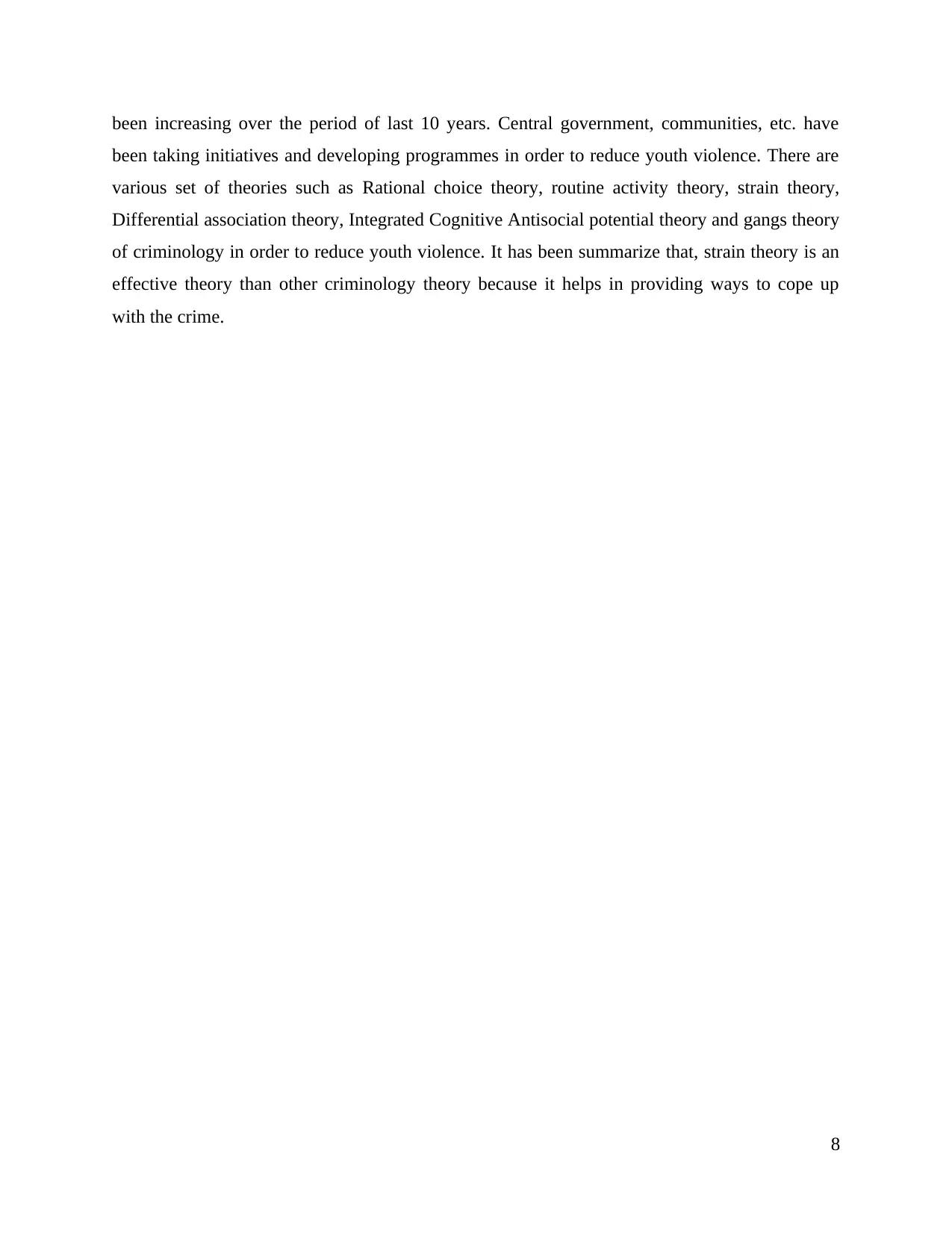
been increasing over the period of last 10 years. Central government, communities, etc. have
been taking initiatives and developing programmes in order to reduce youth violence. There are
various set of theories such as Rational choice theory, routine activity theory, strain theory,
Differential association theory, Integrated Cognitive Antisocial potential theory and gangs theory
of criminology in order to reduce youth violence. It has been summarize that, strain theory is an
effective theory than other criminology theory because it helps in providing ways to cope up
with the crime.
8
been taking initiatives and developing programmes in order to reduce youth violence. There are
various set of theories such as Rational choice theory, routine activity theory, strain theory,
Differential association theory, Integrated Cognitive Antisocial potential theory and gangs theory
of criminology in order to reduce youth violence. It has been summarize that, strain theory is an
effective theory than other criminology theory because it helps in providing ways to cope up
with the crime.
8
Secure Best Marks with AI Grader
Need help grading? Try our AI Grader for instant feedback on your assignments.

REFERENCES
Books and Journals
Barlow, J., 2015. Preventing child maltreatment and youth violence using parent training and
home visiting programmes. Oxford Textbook of Violence Prevention: Epidemiology, Evidence
and Policy, pp.133-140.
Birkland, T.A., 2019. An introduction to the policy process: Theories, concepts, and models of
public policy making. Routledge.
Bushman, B.J and et.al., 2016. Youth violence: What we know and what we need to
know. American Psychologist, 71(1), p.17.
Capuzzi, D. and Stauffer, M.D., 2016. Counseling and psychotherapy: Theories and
interventions. John Wiley & Sons.
David-Ferdon, C and et.al., 2016. A comprehensive technical package for the prevention of
youth violence and associated risk behaviors.
DeLisi, M and et.al., 2018. Self-control versus psychopathy: A head-to-head test of general
theories of antisociality. Youth violence and juvenile justice, 16(1), pp.53-76.
Fleming, P.J and et.al., 2015. Men's violence against women and men are inter-related:
recommendations for simultaneous intervention. Social Science & Medicine, 146, pp.249-256.
Fox, B.H., Jennings, W.G. and Farrington, D.P., 2015. Bringing psychopathy into developmental
and life-course criminology theories and research. Journal of Criminal Justice, 43(4), pp.274-
289.
Hagan, F.E. and Daigle, L.E., 2018. Introduction to criminology: Theories, methods, and
criminal behavior. Sage Publications.
Kanz, K.M., 2016. Mediated and moderated effects of violent media consumption on youth
violence. European journal of criminology, 13(2), pp.149-168.
McClennen, J., Keys, A.M. and Day, M., 2016. Social work and family violence: Theories,
assessment, and intervention. Springer Publishing Company.
Ohmer, M.L., 2016. Strategies for preventing youth violence: Facilitating collective efficacy
among youth and adults. Journal of the Society for Social Work and Research, 7(4), pp.681-705.
9
Books and Journals
Barlow, J., 2015. Preventing child maltreatment and youth violence using parent training and
home visiting programmes. Oxford Textbook of Violence Prevention: Epidemiology, Evidence
and Policy, pp.133-140.
Birkland, T.A., 2019. An introduction to the policy process: Theories, concepts, and models of
public policy making. Routledge.
Bushman, B.J and et.al., 2016. Youth violence: What we know and what we need to
know. American Psychologist, 71(1), p.17.
Capuzzi, D. and Stauffer, M.D., 2016. Counseling and psychotherapy: Theories and
interventions. John Wiley & Sons.
David-Ferdon, C and et.al., 2016. A comprehensive technical package for the prevention of
youth violence and associated risk behaviors.
DeLisi, M and et.al., 2018. Self-control versus psychopathy: A head-to-head test of general
theories of antisociality. Youth violence and juvenile justice, 16(1), pp.53-76.
Fleming, P.J and et.al., 2015. Men's violence against women and men are inter-related:
recommendations for simultaneous intervention. Social Science & Medicine, 146, pp.249-256.
Fox, B.H., Jennings, W.G. and Farrington, D.P., 2015. Bringing psychopathy into developmental
and life-course criminology theories and research. Journal of Criminal Justice, 43(4), pp.274-
289.
Hagan, F.E. and Daigle, L.E., 2018. Introduction to criminology: Theories, methods, and
criminal behavior. Sage Publications.
Kanz, K.M., 2016. Mediated and moderated effects of violent media consumption on youth
violence. European journal of criminology, 13(2), pp.149-168.
McClennen, J., Keys, A.M. and Day, M., 2016. Social work and family violence: Theories,
assessment, and intervention. Springer Publishing Company.
Ohmer, M.L., 2016. Strategies for preventing youth violence: Facilitating collective efficacy
among youth and adults. Journal of the Society for Social Work and Research, 7(4), pp.681-705.
9

Seal, M. and Harris, P., 2016. Responding to youth violence through youth work. Policy Press.
Online
Lecture 2: Youth Violence. 2019. [ONLINE]. Available through<
http://202.129.210.58/projectfiles/internal_cust_document/YouthViolenceLecture158443997840
5_redacted_1584778547.pdf>
10
Online
Lecture 2: Youth Violence. 2019. [ONLINE]. Available through<
http://202.129.210.58/projectfiles/internal_cust_document/YouthViolenceLecture158443997840
5_redacted_1584778547.pdf>
10
1 out of 12
Related Documents
Your All-in-One AI-Powered Toolkit for Academic Success.
+13062052269
info@desklib.com
Available 24*7 on WhatsApp / Email
![[object Object]](/_next/static/media/star-bottom.7253800d.svg)
Unlock your academic potential
© 2024 | Zucol Services PVT LTD | All rights reserved.




